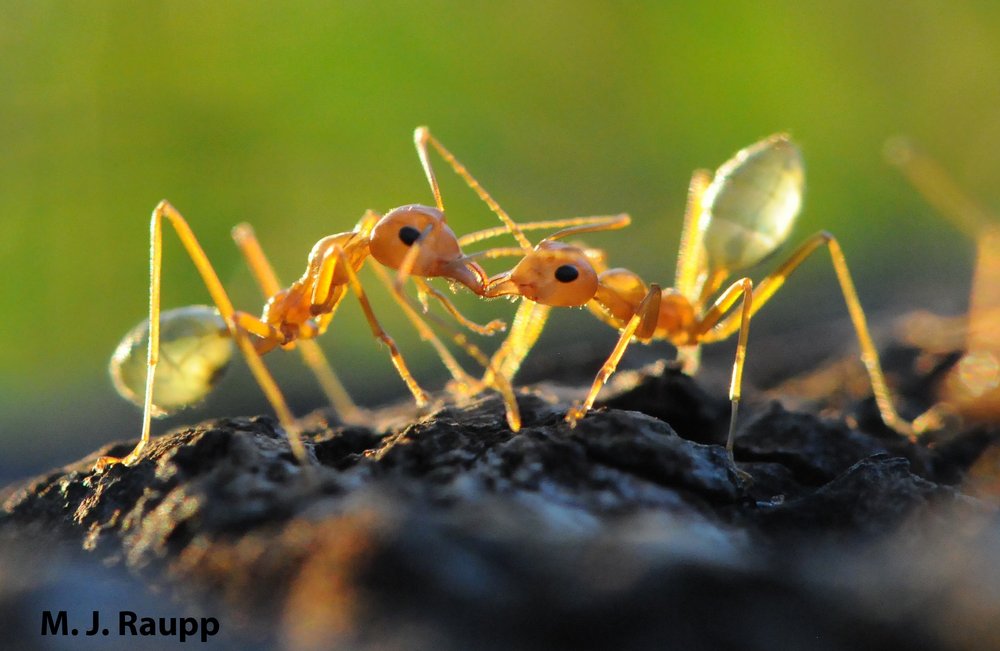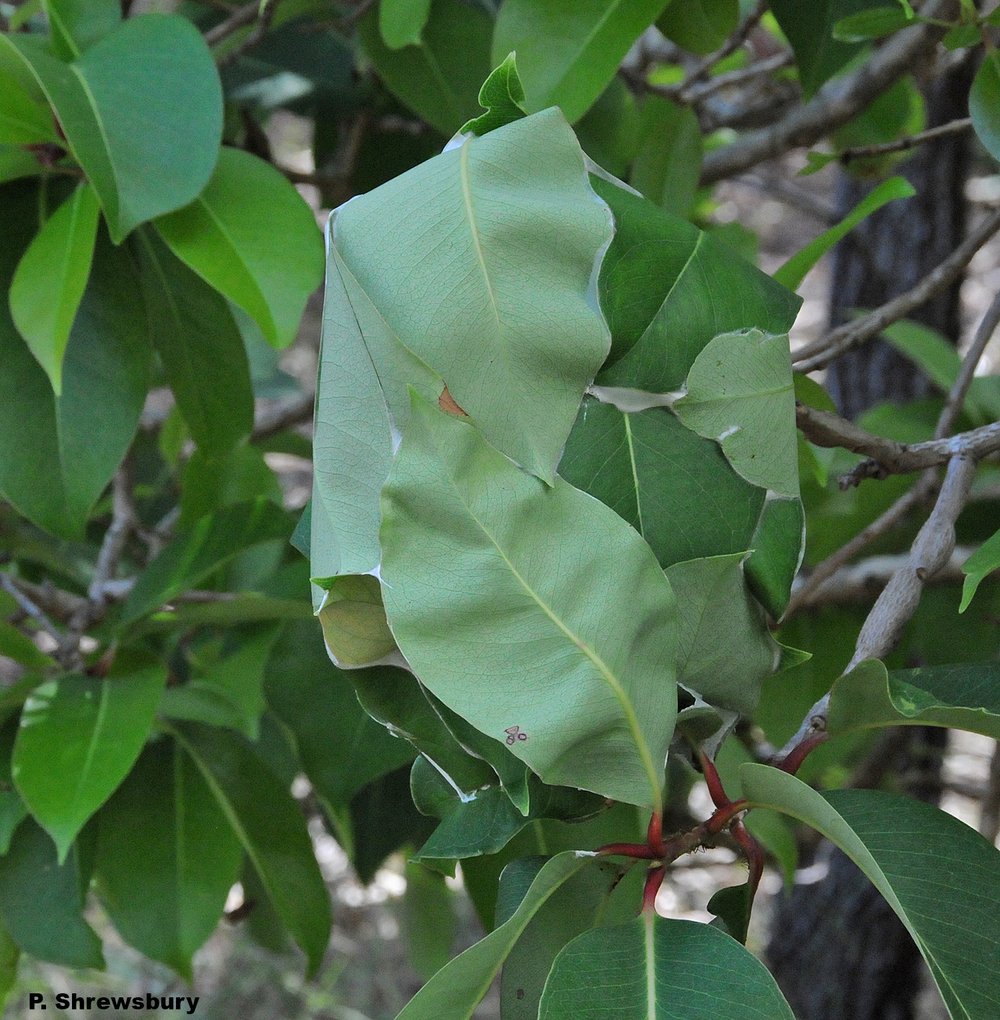Destinations: Lizard Island, Australia and Mulu National Park, Borneo to learn about cooperation – a lesson delivered by Green tree ants, Oecophylla smaragdina

With sharp jaws ready, workers prepare to defend the colony from nosy bug geeks. Image: P. M. Shrewsbury, UMD
In recent episodes we visited traveled to Borneo to visit recycling millipedes, beautiful lanternflies, fierce rainforest ants, and one of the largest ant species on our planet. This week we island hop and make two stops. First stop is Lizard Island just off the coast of Australia on the Great Barrier Reef. Second stop is a return to the rainforests of Borneo. A few years ago, a study abroad landed Bug of the Week on Lizard Island. While bumbling through the underbrush in search of spiders, I bumped into a small tree bearing several football-sized clusters of glossy leaves. I was surprised and delighted when scores of beautiful green ants issued forth from one leaf-cluster and set to work defending their redoubt by dropping on my arm and attacking. Fortunately, the furious soldiers lacked stingers and their bite was mildly unpleasant at worst. Their attack left the air laced with the odor of formic acid released from specialized poison glands as a defense.
Food gathered on the ground will be carried along roots and up into the treetop where nests are built. When nosy humans get a little too close, workers guarding the nest are on high alert, ready to attack.

A pair of workers exchange some information and maybe some food.
Green tree ants and other weaver ants represent a unique branch of the ant’s evolutionary tree. While other more familiar ants build colonies in soil or decaying wood, weaver ants live the life arboreal and construct clever nests in the canopies of trees. Nest building begins when one or more large workers known as majors grasp the margin of a leaf and fold it over or hold it in close proximity to an adjacent leaf. Other majors soon join the effort and, in a fascinating display of cooperation, they stand shoulder to shoulder to pull the leaf margins into close approximation to each other. When the gap narrows the workers stand in place, hold the leaf fast, and await the next step in the nest making process. Other workers gather ant larvae from deep within the colony. These youngsters are approaching their time of pupation, a time when they produce silk, and in their heads are fully functional silk glands. The workers gather several of these larvae and carry them to the construction site where leaf-grasping workers await their arrival. Using the silk-spinning larvae as living bobbins, workers move the larvae back and forth, weaving silk across the gap, firmly stitching the leaves together. This process is repeated time and again with other nearby leaves until the nest is complete.
Some ants, including green tree ants, conduct a remarkable behavior called social carrying where one ant picks up and transports another. This may be a way to get more workers to an important project pronto. Video at about half speed.

A single colony of green tree ants may consist of several smaller nests distributed in several trees. P. M. Shrewsbury, UMD
Green tree ants build multiple nests throughout the tree’s canopy and several trees may be enlisted to house a single colony. In one of these individual nests resides the glorious queen whose task it is to eat meals of protein and carbohydrates brought to her by the workers. These rich nutrients are turned into thousands of eggs. Since workers large and small, young and old, share the same mother, the queen, they are all sisters and the building, care, and defense of the colony truly is a remarkable act of sisterly cooperation. The size of some weaver ant colonies has been estimated to exceed more than 500,000 workers. Like many of their kin, green tree ants are omnivores, consuming other insects they capture and gathering carbohydrates in the form of honeydew excreted by legions of arboreal sucking insects such as scale insects, aphids, and spotted lantern flies we met in previous episodes.
I had a golden chance to witness another extraordinary feat of cooperation in the rainforest of Borneo one evening when weaver ants discovered and captured an enormous scarab beetle. This colossal meal was easily a hundredfold more massive than the weight of a single ant. The problem: How do ants bring this banquet back to the nest to feed the queen and brood? The answer: Sisterly cooperation! As you watch the video, witness scores of worker ants transporting the huge beetle along a wooden rail adjoining a walkway. After encountering a vertical fencepost, ants use sister power to levitate the beetle up and over the post. On the other side of the post a short hike brings them to a leafy bridge that serves as a causeway to their arboreal nest. On the way home as night falls, the crotch between two leaves becomes an insoluble obstacle and the beetle becomes trapped. At sunrise the next morning, the beetle was gone and a solitary worker was stationed at the portal where the leafy trail home met the walkway. Was the beetle dismembered and carried piece by piece back to the nest? Did the sisters lose their grip and drop their prize? Was there an alternate and more passible route back to the nest? Only the weavers know.
Scores of worker ants transport a huge scarab beetle along a wooden rail adjoining a walkway. After encountering a vertical fencepost, ants cooperate and use sister power to levitate the beetle up and over the post. On the other side of the post a short hike brings them to a leafy bridge that serves as a causeway to their arboreal nest. On the way home as night falls, the crotch between two leaves becomes an insurmountable obstacle and the beetle becomes trapped. At sunrise the next morning, the beetle was gone and a solitary worker stationed at the portal guarded the leafy trail from the walkway back to the nest. Video at twice life speed.
Well, green tree ants prove they can cooperate with other members of the family, but how about with other species of creatures, maybe even with humans? The value of weaver ants in pillaging plant-eating insects was recognized nearly 1,800 years ago by citrus growers in China. Ancient writings show that nests of weaver ants were regularly transported and installed in orchards where ravenous workers converted citrus-eating pests into food for the colony and queen. These clever orchardists are credited with one of the earliest records of a practice still widely used in crop protections today called biological control. Maybe humans can learn something about the value of cooperation by taking some time to watch ants.
Acknowledgements
Bug of the Week thanks Dr. Shrewsbury for providing photographs used in this episode and the students and faculty of BSCI 279A, Natural History, Ecology, and Geology of Australia, for providing the inspiration for this story. The spectacular reference “The Ants” by Bert Hölldobler and Edward O. Wilson provided the information used to prepare this episode. We thank Dan for discovering the large scarab beetle seen in this episode, the eagle-eyes of Kristie, Bob, and Pat for spotting insects and Paula for sharing images used in this episode.
This post appeared first on Bug of the Week